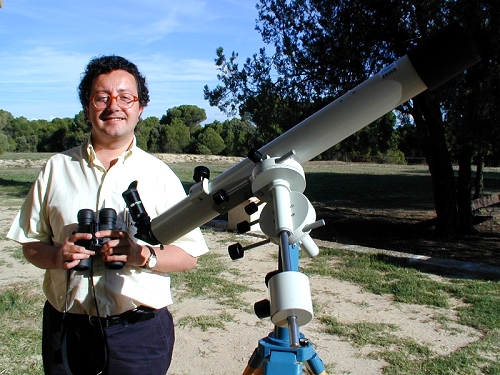|

Location:
Oviedo,
Spain, EU
e-mail:
luis.arguelles@wanadoo.es
Telementor
user since:
Winter 2001
Observing
Site Classification:
Suburban or Rural
Preferred
sky objects:
Double stars, Sun, Open Clusters
Telementor's
best view:
Elongated Epsilon Lyrae at only 21x
Other
telescopes:
Vixen GP-102M, Televue Ranger, Takahashi FS-102
Do
you remember the
first day using your refractor?. Experiences?, Observing?. Did you
remember
the date (year)?
Well, I
received the small
Zeiss the Friday afternoon of 30th, March, 2001. Then the cloudiest
weather
came to Spain from 100 years ago, so soon I was making “mountain
observing”
from inside the living-room of my flat. Anyway, this revealed a very
interesting
thing: In the border where the snow finds dark rock no chromatic
aberration
was found. Later, some artificial stars from light bulbs located about
1 km from my home were rendered as beautiful pinpoints. While
defocusing
these lights, I observed nice diffraction circles with exactly the same
pattern inside and outside focus. I started to suspect this would be a
class refractor.
Some weeks
later, I observed
the Sun (always with a filter, of course), and the results were better
than using a Televue Ranger, and even approaching a very good 4”
achromatic
refractor.
Finally,
clouds opened and
the first stellar light from out of our solar system entered the
Telementor.
Regulus (Alpha Leonis) was beautiful and cranking up the magnification
up to 221x I knew this refractor will be a fantastic observing
instrument
forever.
Which
is you favourite
observing site?. Conditions of the site (weather, limiting magnitude,
altitude,
transparency, "seeing".., etc)?
The
population in Spain is
usually concentrated in flats inside towns, so in order to observe with
the telescope, I always must to drive a bit. In Oviedo there are some
places
in the suburbs that allow casual observing, with 3.0 limiting magnitude
skies. More suitable places are “Via Pará” at about 900 meters
over
sea level while climbing the “Angliru” mountain and “Smoking Hill” (El
Fumeru) at 500 meters over sea level. Anyway, my preferred observing
site
is “Sena de Luna”, located 80 kms south from Oviedo at an altitude of
1,200
meters and with a naked eye limiting magnitude of 5.5-6.0 on new Moons.
Transparency is usually 8-9 in a scale from 0 to 10. Seeing is also
excellent.
What
type of sky objects
do you prefer to observe with your Telementor/Telemator?
Double
stars are my preferred
objects. Incidentally, bright stars such as Antares, Vega, Arcturus,
Sirius,
and the like are lovely thorough this refractor when observed at high
magnification
(I use 221x for this) because the coloration is rendered without false
color and you can enjoy a lot from the intrinsic tones of stars and
nice
diffraction rings.
What
is your best achieved
view or the most incredible view you have got with the Telementor?.
What
is the most beautiful sky object observed with your refractor?
Although a
bit prosaic, Epsilon
Lyrae has been up to now my best “delight” with the Telementor, because
using a Televue star diagonal and a 40mm Plössl eyepiece, I
observed
a clear elongation at only 21x in both doubles from this system. I
needed
to rub my eyes in order to believe what I was observing!
What
eyepieces do you
use?. Other accesories?
I have the
standard Carl
Zeiss Jena H-25mm and the 16mm, 12.5mm and 10mm Carl Zeiss Jena Orthos.
All provide very sharp views, but I also use 1.25" Baader Eudiascopic
eyepieces
in the following focal lengths: 35mm, 20mm, 10mm, 5mm and 3.8mm. I
found
they are so sharp as the Zeiss Orthos, but offering a bit more apparent
field (52º). In order to observe the Sun, I use a Baader solar
filter.
Have
you compared the
small Zeiss with other telescopes?. What were your experiences on this?
Yes. I’ve
compared it with
my 4” Vixen achromat (the wonderful one made in Japan, no the ones made
in China). While the Zeiss has a more quality objective, the Vixen is
also
very good, so the difference in aperture becomes decisive (63mm against
102mm is a lot in this small class). On the other hand, the Zeiss is
rather
easier to transport, so I think I’m going to use more the Zeiss than
the
Vixen, specially for solar observing.
It's
intereting also to note
the Telementor has a better star-test than my Takahashi FS-102.
Although
the FS-102 has an impressive extra and intrafocal difraction rings
image,
the ones from the small Zeiss are even beter. Just imagine!
I’m also
working out a deep
comparison between the Telementor and the Televue Ranger in these days.
It’s a really interesting showdown, and in a near future I’ll write
about
the results. [Update: The Spanish magazine "Tribuna de
Astronomía
y Universo published in the October/2001 issue my article
"Zeiss
Telementor vs. Televue Ranger, dos refractores de gran personalidad"].
Are
you happy with
your refractor?. Pros and cons?
Yes, I’m
happy with it. The
best “Pros” are its excellent optical and mechanical quality. In fact,
the images through it make me to remember the typical “Astrophysics”
image
(or let’s say, Astrophysics images appears as something really close to
Zeiss images!). Mechanically, it’s superior than an Astrophysics, and
this
is a lot to say about a telescope. The only “cons” is the manual device
in RA for following an object in the sky. You need to “rewind” this
actuator
every 30 minutes or so, but soon you get used to it and then it becomes
second nature.
Other
comments?
No more for
now. Only to
say every observer would enjoy using this refractor. When you observe
through
it not only you enjoy the views that it proviedes, but you also know
you
are using an instrument from the best family of telescopes ever built
in
the world.
Clear skies
and Sharp
splitting,
Luis
Argüelles
|